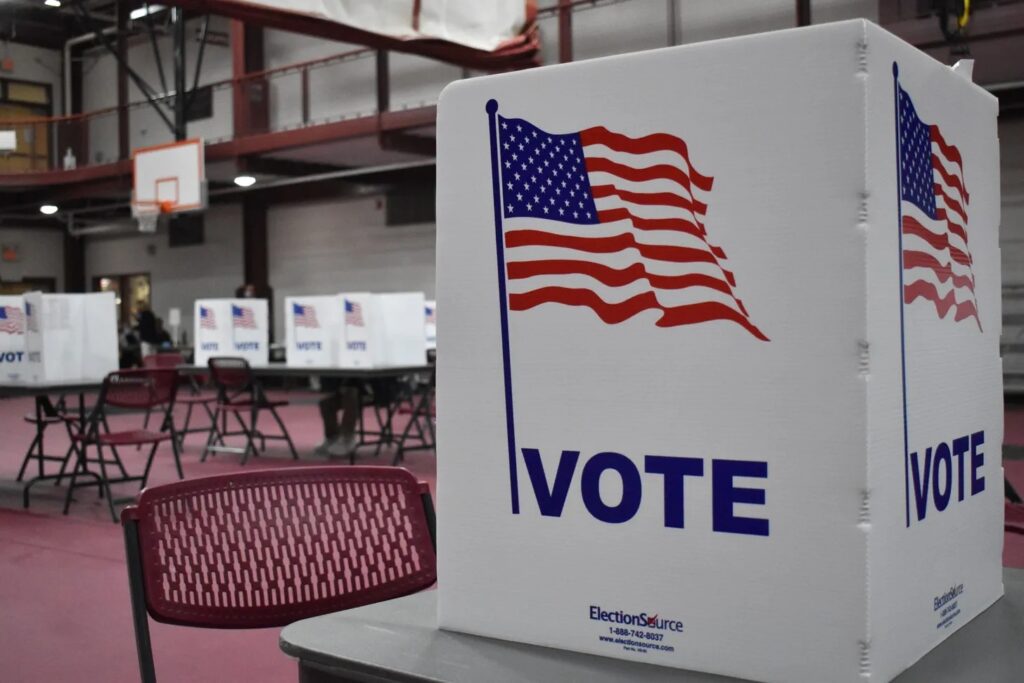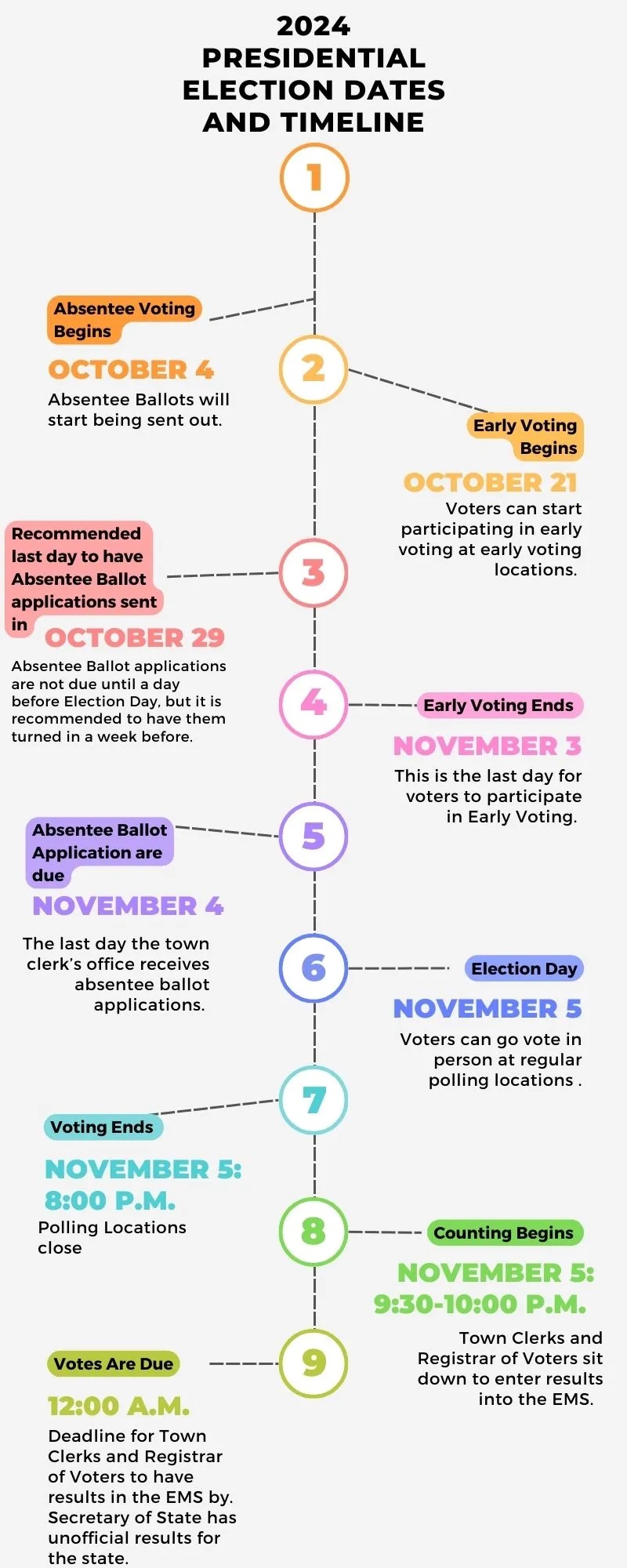
By Gianni Salisbury | UConn Journalism
September 13, 2024
With the 2024 presidential election approaching on Nov. 5, state officials have been working to try to ensure voting in Connecticut will run as smoothly as possible by adopting new laws, providing voters with different ways to cast a ballot and using secure election practices.
This comes against the backdrop of election irregularities in Bridgeport, which has faced scandals involving voter fraud in city elections. The most recent involved Wanda Geter-Pataky, a Democratic town official who was criminally charged along with three others after surveillance footage allegedly showed her stuffing a ballot box with absentee ballots in 2019.
The scandal garnered widespread attention from both sides of the aisle.
Also providing context for the updates is criticism from the ACLU, which recently identified Connecticut as one of the states that was failing to effectively counter its long history of racist voter suppression.
Since then, Connecticut officials have moved to create new voting laws and educate the public on different options for casting a ballot.
Secretary of the State Stephanie Thomas has led this push by helping implement many election reform laws. One such policy is early voting.
Early voting
Starting Oct. 21, for the first time in a general election, Connecticut voters can visit early voting locations to cast their vote up to 14 days before Election Day. Every town in the state is required to have a location. Voters must check in, and receive a ballot and envelope. Voters fill out the ballot in a privacy booth then seal it in the approved envelope. According to the state website, the sealed envelope will be placed in a “secure receptacle as instructed by the election officials.”
To ensure people can’t vote twice, election officials at these locations will record the names of each person casting a ballot. This prevents anyone from voting early at other locations, submitting an absentee ballot or voting on Election Day, according to the secretary of the state’s website. The envelopes containing the ballots remain sealed and unopened until Election Day.
Many state officials have expressed their support of early voting, saying it allows people more chances to vote if they can’t make it to the polls on Election Day. And it has bipartisan support.
State Republican Chairman Benjamin Proto encourages people to use early voting.
“It’s easy. The locations, you can find on the secretary of the state’s website or your own registrar’s websites. It’s quick, it’s easy. You get it done and it’s all over,” Proto said.
State Democratic Chairwoman Nancy DiNardo agrees that early voting makes it easier for voters to get to the polls.
“Early voting is a good thing because there could be people who are away, people could be in the hospital, and having the ability and the choice to be able to vote early and not just on that day is a good thing,” DiNardo said.
Absentee voting
Absentee voting is also a major focus going into the upcoming election. Absentee ballots will be issued starting Oct. 4, 31 days before the general election.

And a referendum question about absentee voting will appear on ballots this year.
Connecticut voters will decide whether the state constitution should be amended to allow no-excuse absentee ballots. A “yes” vote would mean that voters will no longer have to fall under certain categories to qualify for absentee voting.
Current law allows voters to apply for absentee ballots only if they will be out of town on Election Day or can’t vote in person because of sickness or disability, military service or certain religious tenets. Those working during voting hours at a polling place other than their own also qualify.
Options for older voters are now more widely available as well. According to the AARP, an Act passed this year allows Connecticut nursing-home residents who apply for an absentee ballot within six days before Election Day to designate someone to deliver the ballot to them.
Another way people who can’t make it to the polls can vote is through supervised absentee voting.
Peggy Reeves, a former state lawmaker and former state elections director, explains in a video created by the secretary of the state’s office that registrars of voters in each town must conduct supervised absentee voting in institutions with 20 or more registered voters. This could include nursing homes, assisted living, veterans’ health care facilities, mental health facilities and more. Under the supervised absentee voting process, registrars from both major parties or their designees deliver the ballots and supervise voting, according to Reeves.
Giselle Feliciano, Hartford Democratic registrar, explains that this is a common practice in the city.
“Our office here goes to these facilities, helps them fill out the application for the absentee ballot to be delivered to them, and then we will, in return, go back to them with the ballot, enter their facility almost like a polling location,” Feliciano said.
How one obtains and submits an absentee ballot is very specific, according to Patty Spruance, the Windham town clerk and president of Connecticut Town Clerks Association.
The how-tos of absentee voting
In a video created by the secretary of the state’s office, Spruance explains that voters first must apply for an absentee ballot. Applications are available by emailing the secretary of state’s office, calling the town clerk and picking it up in person or receiving it by mail, or accessing the Connecticut Online Absentee Ballot Request Portal.
Voters must fill out the application, including their reason for needing an absentee ballot. Voters can return the application through the mail, drop it off in a ballot box or bring it to the town clerk’s office.
Voters will receive two envelopes with their absentee ballot to ensure the safety of their vote, according to Spruance. Once they’ve filled out the ballot, voters put the ballot in “envelope B” and seal, sign and date the envelope. That envelope goes into an outer envelope with the town address on it. Voters then can mail their ballot to the town clerk’s office or place it in a ballot box. An immediate family member or designee designated by the voter also can return the ballot, but the person returning it must sign the outer envelope and present ID when returning it. This allows for a paper trail that helps keep the election secure, according to Spruance.
Absentee ballots are stored along with early voting ballots until Election Day to be opened and counted. However, voters can vote in person even if they have already submitted an absentee ballot. If this occurs, town clerks must destroy that voter’s absentee ballot and use their in-person vote instead, Secretary of State Thomas said in a video on the office’s website.
Ballot security
Election Day takes place Nov. 5 and will include in-person voting, curbside voting for those who need it, and same-day registration.
The state is also implementing a pilot program to update its voting tabulators, which were last changed in 2006. Nine communities will test out new machines this year before a planned statewide rollout next year.
Connecticut’s voting system is based on paper ballots. Voters feed their ballots into a reader and a tabulator scans the results. Results are available on a memory card while the paper ballots are secured in the machine. The machine is locked and only election moderators are given the keys.
Proto, the Republican state chairman, said it’s a good system. “Ours is completely paper. We are not connected to the internet. Machines have no modems in them, so they are not hackable. The machine reads the colored boxes, just like the SATs. I think it’s a very transparent system,” he said.
Absentee and early voting ballots are sealed in the town clerk’s office until Election Day, when they are taken to a central count office, opened and counted, the Hartford registrar said.
“On Election Day I have a head moderator that goes out and collects the sealed ballots and then goes upstairs with several of what we call counters, and they sit there and open and make sure everything is correct,” Feliciano added.
According to the National Conference of State Legislatures, for an absentee ballot to count “the inner envelope of an absentee ballot must be signed by the voter under penalties of false statement. If the statement on the inner envelope is not signed as required, the ballot is rejected.”
Once voting ends, each town’s registrar of voters or town clerk has until around midnight to report the totals to the secretary of the state, according to Feliciano. In Hartford, she is in charge of recording these numbers as a registrar. In other towns, the town clerk may get this job. They usually have everything set to begin entering voting information between 9:30 and 10 p.m.
Feliciano said she and the head moderators take the numbers that each tabulator spits out from each polling location and enter the information into the state’s Election Management System (EMS). The numbers must be entered for each polling station, so the time needed to register the results depends on the number of stations in the municipality.
“We have to enter a number for every candidate in every polling location. If you have 20 candidates in polling location 1 we have to enter all 20 numbers, and we have to repeat the process for every polling location. It is a very tedious process,” Feliciano said.
Feliciano and her moderators enter as much information as possible before the midnight deadline. Sometimes they go past the deadline, and occasionally the secretary of the state will give leeway for a little more time to put in the information.
She and the moderators will return the next day and “review everything again” to make sure the information is complete and correct, Feliciano said.
At the end of Election Night, Feliciano emails the secretary of the state a notification that the city has submitted to the EMS. She also will also email the town clerk so town officials will have the unofficial count. The count will remain unofficial until the secretary of the state’s office certifies the numbers.
State officials’ goal this year was to make voting more secure. Through implementing early voting and opportunities for secure absentee voting, DiNardo believes that the secretary of state has done just that.
“The reason why those things were put in place was to make sure that the voting is done properly, and there’s no issues around it,” the Democratic state chairwoman said. “… The secretary of the state’s office wanted to implement these changes to make sure that every vote is an honest vote, and every vote is counted.”
DiNardo added: “Any changes that are made, I think, are always for the good.”
Proto said Connecticut’s election process is one of the most secure and effective in the country and encourages people to go out and vote.
“Vote for the candidate of your choice. If you want to change things that are happening in this country, in our state, then you need to exercise the utmost fundamental right,” he said.
Feliciano also hopes for a big turnout.
“We are preparing for long lines. We are preparing for folks not to be registered. Our registry has grown,” she said.
According to online registration, Hartford has gained 2,000 new registered voters, bringing the capital city to 64,230 registered voters as of Sept. 3.
This article is part of U.S. Democracy Day, a nationwide collaborative on Sept. 15, the International Day of Democracy, in which news organizations cover how democracy works and the threats it faces. To learn more, visit usdemocracyday.org.
